 |
General Audience Kids & Parents Special Interest
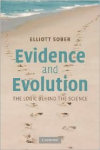 Evidence
and Evolution: The Logic Behind the Science
Evidence
and Evolution: The Logic Behind the Science
by Elliott Sober
Cambridge, 2008
In this scholarly and clearly written book, Elliott Sober, Professor
of Philosophy at the University of Wisconsin-Madison, examines the nature
of scientific evidence and how it relates to the theories of natural selection
and intelligent design. This is a highly technical book, describing a
probabilistic view of evidence with many ideas expressed in mathematical
symbols. It is also features exceptionally lucid prose and numerous examples
of the application of this view of evidence to such questions as whether
intelligent design is untestable, whether the fact that many adaptations
are imperfect discredits intelligent design, and how evidence bears on
the question of common ancestry. This is a highly rewarding read for anyone
willing to devote serious thought to evaluating the evidence for intelligent
design and for natural selection.
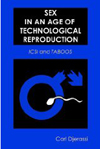 Sex in an Age of Technological Reproduction
Sex in an Age of Technological Reproduction
Two Plays by Carl Djerassi
University of Wisconsin Press, 2008
This book contains two more of Carl Djerassi’s “pedagogic wordplays”. The first play’s title, ICSI, stands for intracytoplasmic sperm injection, an artificial insemination technique. It’s one of the assisted reproductive techniques that are separating sex from reproduction. The play consists of a hypothetical interview of a researcher by a television reporter who is somewhat adversarial and sensation-minded. The second play, Taboos, sets up an interaction between a lesbian couple seeking to have a child and a heterosexual couple who are religious fundamentalists (the husband of the heterosexual couple is the brother of one of the women in the lesbian couple). The play explores the meaning of “family” and “parent” when science allows people to reproduce outside the cultural norms. Like Djerassi’s other “science in fiction” works, the plays attempt to “smuggle” science to a larger audience and explore the social and cultural ramifications of new discoveries and techniques. Like NO, the book comes with a DVD of videos and images.
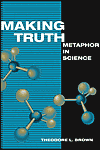 Making
Truth: Metaphor in Science
Making
Truth: Metaphor in Science
by Theodore L. Brown
University of Illinois Press, 2003
Brown, a chemistry professor and
textbook writer, advances a controversial idea–that scientific inquiry
and understanding is often based on conceptual metaphor. For example,
a cell is often called a factory and biochemists use the concept of a
“chaperone” protein to describe a protein that prevents unwanted
interactions. Since metaphors are based on everyday life, they have cultural
roots, and Brown argues that the way we think about a subject can distort
our inquiry into it and our interpretation of the results. Brown says
the central problem of science is making a connection between a metaphor,
which serves as a kind of model or theory, and the results of experiments.
Many scientists think of their work as an objective search for truth and
reject the idea that science, like all human activities, has a cultural
aspect. The book continues an ongoing dialogue about the way scientists
think and work.
 Newton’s
Darkness–Two Dramatic Views
Newton’s
Darkness–Two Dramatic Views
by Carl Djerassi and
David Pinner
Imperial College Press, 2003
As the name implies, these plays explore the dark side of the personality of Issac Newton, focusing on his feuds with two other scientists over getting credit for discoveries. The title of Pinner’s play, Newton’s Hooke, refers to Robert Hooke, who also claimed credit for the discovery of the law of gravity. Djerassi’s play, Calculus–Newton’s Whores, explores Newton’s dispute with Gottfried Leibniz over credit for the invention of calculus. The authors make a case that Newton sometimes acted unethically and they say in their introduction, “At stake is an issue that is as germane today as it was 300 years ago: a scientist’s ethics must not be divorced from scientific achievement.” Djerassi is a distinguished chemist best known as the father of the birth control pill. He has devoted considerable effort to what he calls “science-in-fiction”, designed to “smuggle” science to the public. Pinner is a veteran actor, director and playwright who has had 18 plays produced on stage and many more on radio and television. For a longer review by Professor Shakhashiri click here: C&EN News Website.
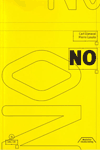 NO
NO
A play by Carl Djerassi
and Pierre Laszlo
Deutscher Theaterverlag, 2003
NO is a relatively short “pedagogic
wordplay” designed to be read in classrooms and similar settings
rather than being fully staged. NO is nitric oxide, which has only recently
been discovered to have many vital functions in the human body from penile
erection to blood clotting to promoting nerve impulses. In the play, two
scientists discuss NO with a venture capitalist who is a potential backer
of their research. In the process, the audience learns a lot about science
and the funding of scientific research. The co-authors are Carl Djerassi,
a distinguished chemist best known as the father of the birth control
pill, and Pierre Laszlo, a prolific French science writer who has been
a professor of chemistry at several distinguished universities. Djerassi
has devoted much of his time in recent years to “science-in-fiction”,
attempting to “smuggle” science to the general public in the
form of novels and plays. This book includes German, English and French
versions of the play and a unique feature–a CD with the visuals
used by the scientists in the play and a rap song about NO. The rap song
always gets a big response from audiences and makes NO unforgettable.
We highly recommend this marriage of science and art. Djerassi maintains
his own web site, www.djerassi.com.
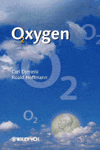 Oxygen
Oxygen
by Carl Djerassi and
Roald Hoffmann
Wiley-VCH-Weinheim, 2001
This play by two renowned chemists
explores the human side of science, asking who should get credit for discovering
oxygen (all three claimants and their wives are presented). Carl Djerassi
of Stanford is one of the few recipients of both the National Medal of
Science and the National Medal of Technology and Roald Hoffmann of Cornell
University is a Nobel Laureate . The play has been translated into many
languages and produced in several countries. To order a DVD of a production
at the University of Wisconsin-Madison, click
here.
 Science,
Money and Politics: Political triumph and Ethical Erosion
Science,
Money and Politics: Political triumph and Ethical Erosion
by Daniel S. Greenberg
University of Chicago Press, 2001
Veteran science writer Daniel Greenberg provides a detailed review of science funding in the U.S. since World War II and concludes that the science establishment has consistently and falsely claimed a lack of funding, an impending shortage of scientists and a lack of public respect. Greenberg also asserts that science is now endangered by “corporate contamination of academic scientific integrity” and a governmental/academic system that’s “bureaucratically calcified”. Greenberg’s prescription is to, “dislodge science from it’s comfortable ghetto and move it into the rough waters of the political mainstream,” where there would be more public accountability for the billions of dollars spent on research. Some will disagree with Greenberg’s conclusions in this thought-provoking book, but it provides a valuable overview of the politics and money behind scientific research.
 A
University for the 21st Century
A
University for the 21st Century
by James J. Duderstadt
University of Michigan Press, 2000
Duderstadt, President Emeritus of the University of Michigan, says major changes are inevitable in higher education–the question is what form they will take. He analyzes the forces effecting universities, and there are many--technological, political, economic, social and cultural. While American universities have been very successful in many ways, Duderstadt says they are not well adapted to the rapidly changing world of the 21st century and will have to undergo the greatest transformation in their history. He predicts that the university of the future will be as different from today’s institutions as the research university is from the colonial college . In this comprehensive book, Duderstadt offers an action agenda to equip universities to continue making great contributions to society, an agenda which should interest anyone who cares about the future of higher education.
Fun
with Chemistry: A Guidebook of K-12 Activities, Volumes 1 and 2
by Mickey and Jerry Sarquis
The Institute for Chemical Education, 1991 and 1993
 Chemical
Demonstrations: A Handbook for Teachers of Chemistry,
Chemical
Demonstrations: A Handbook for Teachers of Chemistry,
Volumes 1, 2, 3, and 4
by Bassam Z. Shakhashiri and collaborators
The University of Wisconsin Press, 1983, 1985, 1989, and 1992.